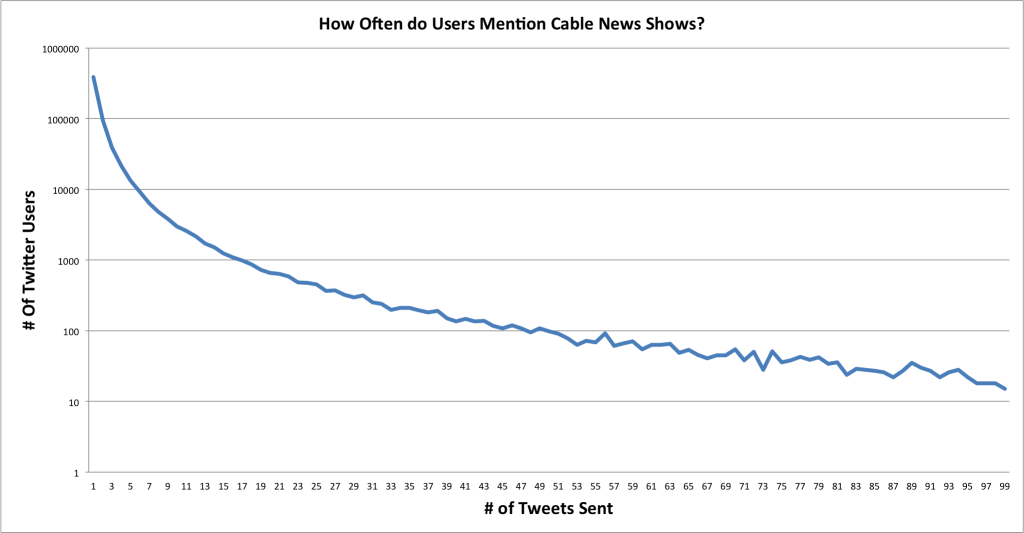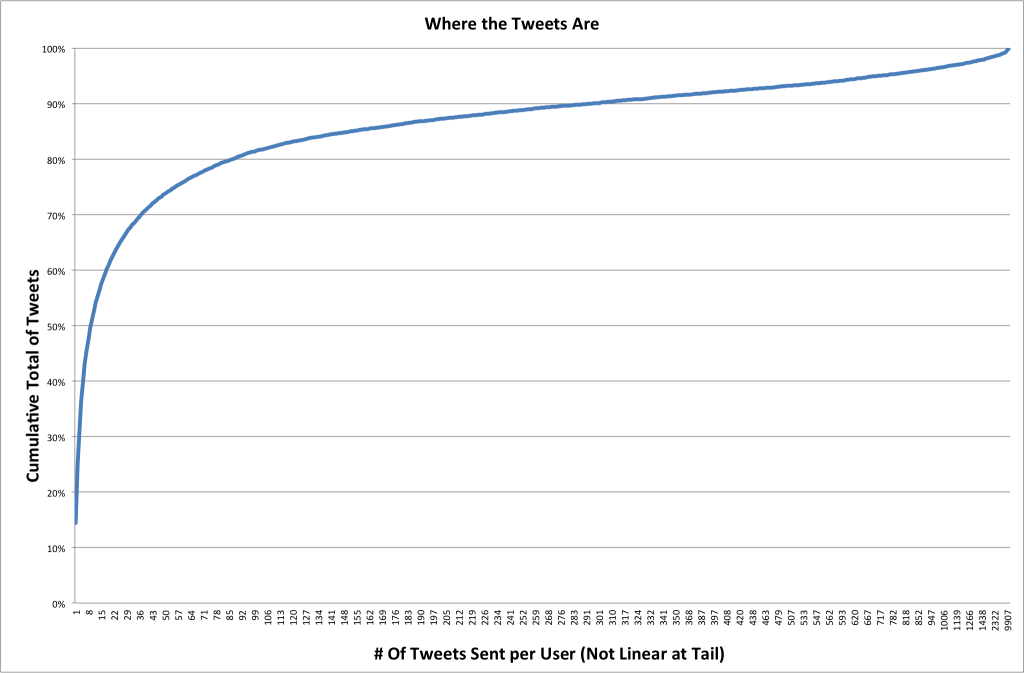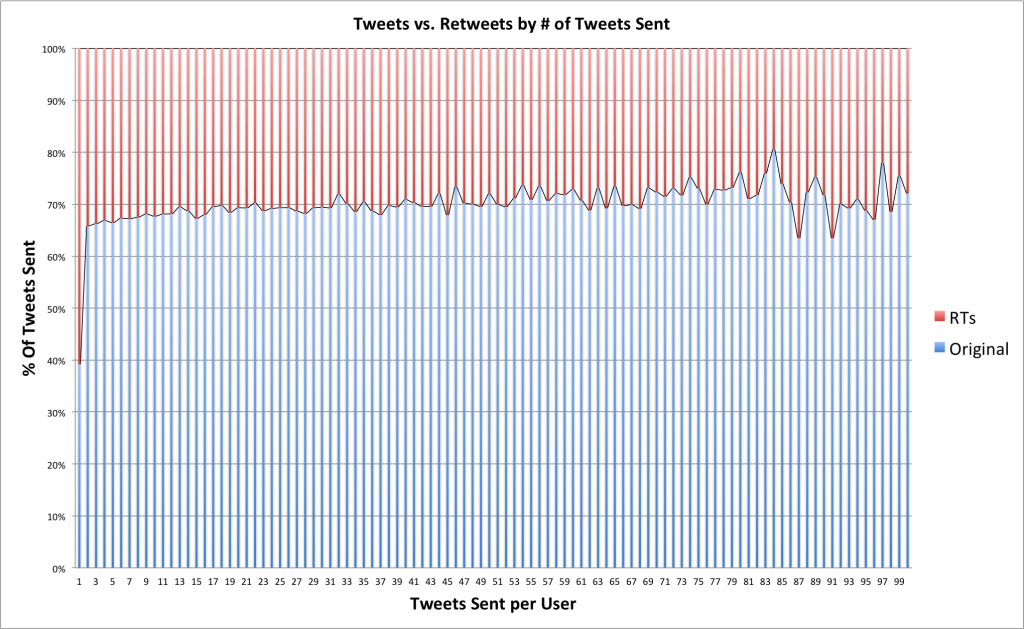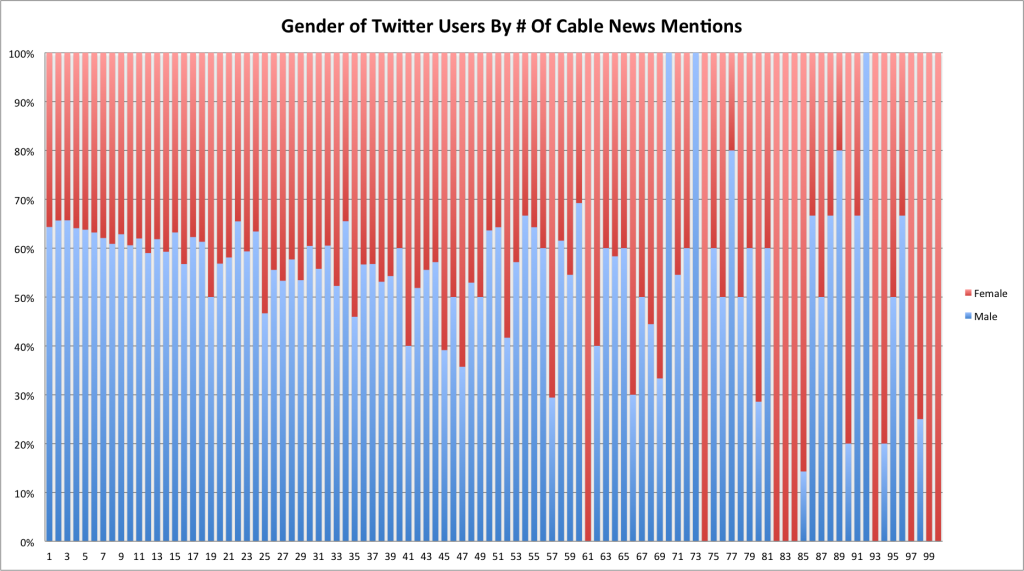 Who Tweets to Cable News Shows?
Who Tweets to Cable News Shows?
If you look at the overall volume of tweets that mention cable news shows, it’s clear that there’s a lot of chatter going on. But who are all these people? How engaged are they? Are they people who casually mention a show once and then never again, or are they engaged in a conversation with and about cable news shows?
To answer these kinds of questions, I analyzed all tweets mentioning cable news shows over the span of a four week period. During that period, approximately 600,000 distinct Twitter screen names tweeted over 2 million messages that mentioned either a show or a host — a little over three tweets per user, on average.
Engagement Rates
The number of tweets a user sends is the strongest metric of engagement there is: the more you tweet, the more involved you are with a show online. So it’s natural to wonder how many users are frequent tweeters vs. how many are infrequent. Here’s a chart that shows the distribution of users, from infrequent to more frequent:
Note that this is a logarithmic plot; there are almost 400,000 users who only mentioned a cable news show once in the four week period, while there were about 400 users who mentioned a cable news show 25 times. I cut the chart off at 100 mentions; there were still many users who made more than 100 mentions. In fact, there were two Twitter screen names who each re-tweeted cable news mentions over 9000 times; clearly, they are some sort of bot.
We can see, clearly, that the bulk of the users mention a cable news show infrequently. About 2/3rds of the Twitter users who mentioned a cable news show only did so once in the four week period. 99% of all users who mentioned a show did so less than 33 times in the four week period.
Distribution of Tweets
Another way to look at all this is not by users, but by tweets. If we plot the cumulative volume of tweets, we can see what portion of the incoming mentions are from frequent vs. infrequent users:
If you pick any tweet that mentions cable news at random, there is a 50% chance that the person who sent it has mentioned cable news 9 times or less during that four week period. About 75% of the tweets come from people who’ve tweeted 25 or fewer mentions.
Tweets vs. Retweets
Another statistic of interest: Are these all original tweets, are are they just a collection of retweets echoing endlessly off the walls of Twitter? Overall, about 53% of the tweets are original, while 47% of tweets are retweets. But the number of original tweets goes up as the frequency of tweeting goes up:
We can see that, for people who mentioned a show only once over the four week period, about 60% of them are just retweeting something. And that’s a lot of people who retweet just once. But after that, it quickly becomes about 70% of all tweets that are original, reversing the ratio and then some. All but the most casual of Twitter users (in terms of mentioning shows) prefer to write their own tweets.
Demographics of People who Mention Cable News Shows
Finally, a little demographic information. Over all, about two thirds of people who mention cable news shows are male, and a third are female. This is quite different from the overall breakdown of Twitter users, which is thought to be slightly more female. But as the number of mentions of a show goes up, we can just make out a shift in that balance taking place:
We can see that, as the number of mentions goes up, the mentioners become slightly more female. There are a couple of caveats about this, however. First, this is a sample over approximately two weeks, not the four weeks in the previous charts; so the counts are compressed in the chart as a result. Second, the number of users starts to drop off fairly quickly and the data becomes very noisy. For the category of people who mentioned any show just once during the two weeks, there were about 130,000 people who fell into that category. For the category of people who mentioned shows 25 times during the two weeks, there were 75 of them. Too far after that and the sample sizes become impossibly small to be meaningful.
Conclusions
 What can we conclude about all this? First, it’s clear that the mentions cable news shows receive tend to come from a broad swath of Twitter users, not just a very small vocal minority. It’s true that only a small fraction of Twitter users mention cable news shows at all, but those that do are generally not obsessive or excessive in their tweeting.
What can we conclude about all this? First, it’s clear that the mentions cable news shows receive tend to come from a broad swath of Twitter users, not just a very small vocal minority. It’s true that only a small fraction of Twitter users mention cable news shows at all, but those that do are generally not obsessive or excessive in their tweeting.
Second, it implies that the depth of engagement with cable news shows is fairly shallow; people are not dialoging so much as telegraphing their opinions here and there. Social Media managers for the various shows would do well to consider ways to enhance the ongoing conversation with their users.
Finally, we’ve learned that a large majority of people who tweet to cable news shows are male, but as the engagement rate goes up (as measured by frequency of tweeting) the user base becomes slightly more female. Cable news shows looking to engage their audiences may find appealing to the female base the best way to get better responses.
But given the lop-sided male demographics of the mentioners, we need to adjust our expectations of how cable news shows are perform on Twitter. A show that has a male to female ratio is 1:1 on Twitter is doing exceptionally well with women.
Twitter is still a predominantly anonymous and ambiguous means of engagement, but by looking at aggregates we can begin to see a picture form of who, out there, is talking back to the shows.
Notes on methodology (if you really, really want to know):
- The date for the larger data sets is from 8/28 through 9/24, roughly. The smaller data set (gender) is from 9/11 through 9/24.
- All tweets that mention a cable news show’s official twitter account, the account of its host(s) (when there are a small number of hosts), or a show’s official hash tag were captured. It’s possible that I’ve missed some (given that various networks vary in how well they document their Twitter accounts). And some shows (I’m looking at you, Fox News) appear to have no presence on Twitter at all.
- The gender of the senders was determined via the process outlined in this post. It’s not perfect.




